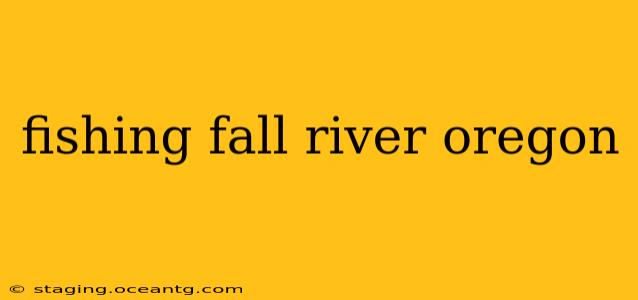Fall River, Oregon, a pristine tributary of the Willamette River, offers anglers a diverse and rewarding fishing experience. Known for its stunning scenery and robust populations of various fish species, it's a popular destination for both seasoned anglers and newcomers alike. This comprehensive guide covers everything you need to know to plan a successful fishing trip to Fall River.
What types of fish can I catch in Fall River?
Fall River is home to a healthy population of several fish species, making it a diverse and exciting place to fish. The most common catches include:
- Rainbow Trout: These vibrant fish are the most prevalent in Fall River, providing ample opportunity for anglers of all skill levels. Their size varies depending on the time of year and location within the river.
- Steelhead: While less abundant than rainbow trout, steelhead runs occur periodically, offering an exciting challenge for experienced anglers. These powerful fish require strong tackle and skillful technique to land.
- Cutthroat Trout: Smaller than rainbow trout, cutthroat trout are still a valuable catch and contribute to the overall biodiversity of the river.
What is the best time of year to fish Fall River?
The ideal time to fish Fall River depends on your target species and preferred fishing methods. Generally, the best times are:
- Spring and Summer: These months offer excellent opportunities to catch rainbow trout, with many smaller fish providing consistent action.
- Fall: Fall brings the possibility of steelhead runs, though their presence can be unpredictable. This season also provides cooler temperatures, making for a more pleasant fishing experience.
- Winter: Winter fishing can be challenging due to colder water temperatures, but dedicated anglers might still find success targeting trout in deeper pools.
What are the fishing regulations for Fall River?
Before you head out, it's crucial to familiarize yourself with Oregon's fishing regulations. These regulations change periodically, so always check the Oregon Department of Fish and Wildlife (ODFW) website for the most up-to-date information. Key factors to consider include:
- Fishing Licenses: Ensure you have a valid Oregon fishing license before you begin fishing. Different licenses cater to residents and non-residents.
- Bag Limits: Be aware of the daily bag limits for each species. Exceeding these limits can result in hefty fines.
- Size Restrictions: Some species might have minimum or maximum size restrictions, meaning you can only keep fish within a specific size range.
- Gear Restrictions: Certain areas of Fall River may have restrictions on the types of fishing gear permitted.
What kind of fishing gear is recommended for Fall River?
The best gear for Fall River fishing depends on your target species and preferred fishing technique. However, some general recommendations include:
- Rods: Lightweight to medium-weight spinning or fly rods are suitable for trout fishing. For steelhead, a heavier rod might be necessary.
- Reels: Choose a reel with a smooth drag system to handle the fight with larger fish.
- Line: Use a line appropriate for your rod and target species. Fluorocarbon leader is highly recommended for stealthy presentations.
- Lures & Flies: A variety of lures, such as spinners, spoons, and small crankbaits, can be effective. Fly fishing enthusiasts will find success with various nymph patterns and dry flies, depending on the season and insect activity.
Where are the best fishing spots on Fall River?
Fall River's beauty lies in its accessibility, with numerous access points along its length. However, some areas consistently produce better results than others. It's always advisable to consult with local fishing shops or experienced anglers for the most up-to-date information on prime fishing spots. Remember to respect private property and stay on designated trails.
What are the common mistakes to avoid when fishing Fall River?
Several common mistakes can significantly impact your fishing success in Fall River. Avoid these pitfalls:
- Ignoring Fishing Regulations: Always adhere to Oregon's fishing regulations to ensure a sustainable fishery and avoid potential fines.
- Using Incorrect Gear: Selecting the appropriate gear for your target species and fishing method is crucial for success.
- Poor Technique: Practice your casting and retrieve techniques to maximize your chances of hooking a fish.
- Neglecting Weather Conditions: Be mindful of weather changes, as they can affect fish activity and your fishing experience.
By following these guidelines and doing your research, you can enjoy a memorable and successful fishing trip to Fall River, Oregon. Remember always to practice catch and release whenever possible to preserve the river's health and ensure its beauty for future generations. Remember to check the ODFW website for the most current regulations and information before your trip.
